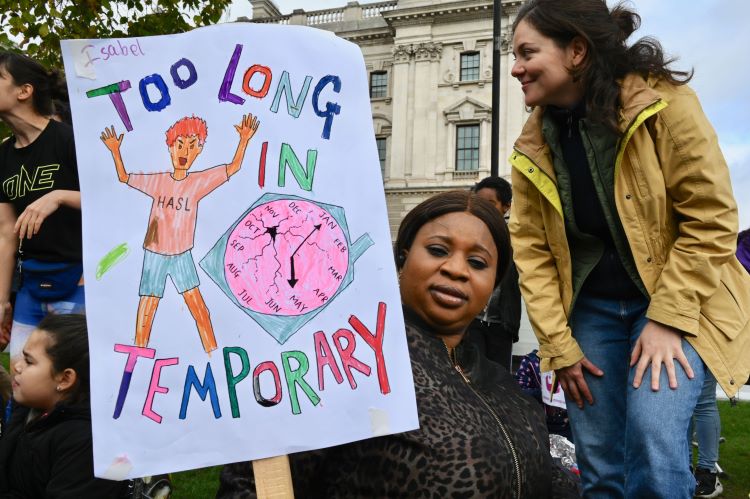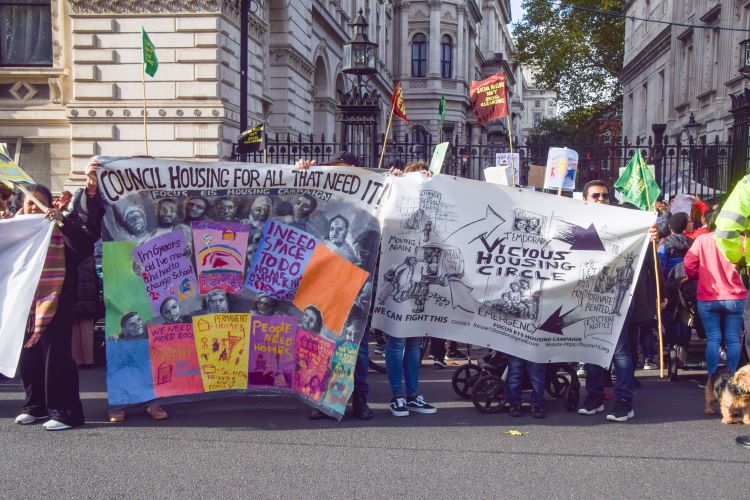Thousands Trapped In Overcrowded Temporary Housing For Months, Figures Show
7 min read
Thousands of homeless people placed in temporary accommodation across England are faced with severe overcrowding, with hundreds – including families with children – stuck in cramped conditions for months at a time.
Figures obtained by PoliticsHome showed individual areas where more than 1,000 households were living in overcrowded temporary accommodation. There were 500 households where more than five people were crammed into a one bedroom property – more than half of those for over six months. One council had seen a 200 per cent increase in the number of people needing emergency housing over three years.
Labour has accused the government of abandoning the most vulnerable in society, who have been “routinely failed by a broken system”, and has pledged to “restore social housing” stocks if the party were in government to alleviate the issue.
When a person becomes homeless, councils have a legal duty to house them in temporary accommodation (TA) – which can include hotels, Bed & Breakfasts, bedsits and privately rented housing – when a suitable long-term home. A decline in the number of social housing units in recent years means it can take months, or even years, before people are able to find a permanent, affordable place to live.

Temporary accommodation housing figures obtained by PoliticsHome under the Freedom of Information Act show:
- 771 four-person households are living in one-bedroom temporary accommodation (TA) units – with 356 of them living there for at least six months.
- 546 households comprising five or more people are living in one-bedroom TA units – 320 of them for more than six months.
- 1,374 households comprising five or more people are living in two-bedroom TA units – 947 of them for at least six months.
National totals are likely to be higher, as the data covers responses from 214 of England’s 296 councils with housing responsibilities. Some large local authorities provided no figures, including in London, the epicentre of the housing crisis.
The legal definition of ‘overcrowded’ housing allows councils some leeway – under one definition, living rooms and studies are counted as acceptable bedrooms. Most councils did not give figures on how many households they assessed as living in ‘overcrowded’ TA – but across 74 councils that did, 2,742 households are considered to be living in overcrowded TA units.
Paula Barker, Labour’s shadow minister for homelessness and rough sleeping, said the figures represented “far too many” people subjected to cramped and unsuitable living spaces.
“Since the Conservatives came to office in 2010, the number of households in temporary accommodation has doubled,” she told PoliticsHome.
“While our most vulnerable, including thousands of children, are being routinely failed by a broken system, this government has no strategy to address all forms of homelessness.
"Safe and secure housing is a fundamental human right. That’s why the last Labour government brought 1.4 million social homes up to a decent standard and why the next Labour government will build more affordable homes and restore social housing to the second largest form of tenure.”
Clive Betts, Labour MP for Sheffield South East and chair of the Levelling Up, Housing and Communities Committee, told PoliticsHome that one-bedroom housing was “totally unsuitable” for a family of four or more people.
“If it was a matter of less than a week, a few days, that's one thing. If they're there for many weeks or months: totally unacceptable,” he continued.
But he believed that local authorities were simply unable to cope with the “growing” pressures of homelessness.
“If you've got a family, say with four or five kids, and you really want a four bedroom house, there probably just aren't any,” he said.
“Just in my own area, each year the number of [social rent] houses with four or more bedrooms that become available, you can probably count them on one hand.”
Among the worst affected areas is Haringey in North London, one of the capital’s most deprived boroughs. Council data shows 1,035 households are living in overcrowded TA according to its minimum size criteria. The local authority has 216 households comprising five or more people housed in one-bedroom TA, of whom 211 have been there longer than six months.
The council’s minimum size criteria for TA states: “Households in temporary accommodation will often be placed into units with 1 bedroom less than they would be entitled to on a permanent basis, with the expectation that the living room provides dual purpose as a living and sleeping area.”
Sarah Williams, Haringey Council’s cabinet member for housing said that last year the council received more than 4,400 homelessness applications, “one of the highest in London”, and pointed to welfare cuts, lack of affordable private sector housing and a cost-of-living crisis as key drivers.
“I realise temporary accommodation is not ideal, but we are doing what we can with limited resources to help those most in need,” she explained.
“A combination of right to buy and a chronic shortage of social housing means we simply do not have sufficient permanent accommodation of our own to offer, and a chronic shortage of family-sized accommodation in the private sector also means limited options for temporary accommodation.”
In south London’s Lambeth, one of the city’s richer boroughs, but with significant pockets of deprivation, 31 four-person households have spent at least six months in one-bedroom TA, while 43 households comprising five or more people have been stuck for six months in two-bedroom TA.
We see teenagers doing their homework in the bathroom, toddlers with no space to learn to walk, and desperately worried parents
“In many of these cases, the level of overcrowding is so serious that it meets the legal definition of statutory overcrowding, which has an extremely high threshold,” said Liz Wyatt of Housing Action Southwark and Lambeth.
“These cramped and dangerous conditions cause unimaginable suffering with children bearing the brunt of this. So many children talk to us about the health conditions they have developed and that have worsened living in temporary accommodation including anxiety, stress, asthma, skin infections.”
A Lambeth Council spokesperson said: “In the face of high demand and a severe shortage of social housing, it is not always possible to find suitable, permanent accommodation; we therefore have to house some people in temporary accommodation until a permanent home becomes available.
“We are extremely sorry that some families are in temporary accommodation that does not meet their needs. But we continue to offer all families advice and support, and advise them to continue bidding for any properties that become available.
“Households in temporary accommodation also have a right of review if they feel the accommodation offered to them is unsuitable for their needs.”
While London has some of the most severe instances of overcrowded temporary accommodation, the issue is prevalent across the country. Cornwall Council said it had 212 households in overcrowded TA.

“In the last three years, the number of households in need of emergency accommodation has increased by around 200 per cent to 750,” a Cornwall Council spokesperson said.
“There is no quick fix and sometimes residents have to be housed in temporary emergency accommodation which is not ideal for their needs as we try and find them more suitable – ideally, long-term – accommodation.”
Cornwall council said it was investing in more council housing and buying up homes on the open market.
Housing charity Shelter’s chief executive Polly Neate said the organisation dealt “every day” with people facing cramped temporary accommodation for lengthy periods, and urged the government to unfreeze housing benefits and invest in more social housing.
“We see teenagers doing their homework in the bathroom, toddlers with no space to learn to walk, and desperately worried parents,” she said.
A spokesperson for the Department of Levelling Up, Housing and Communities said: “Where homelessness cannot be prevented, temporary accommodation is an important way of ensuring no family or vulnerable person is without a roof over their head.
“To ease pressures, we are increasing the supply of affordable housing and our £11.5 billion Affordable Homes Programme will deliver thousands of affordable homes for both rent and to buy right across the country.
“Since 2010, we have delivered over 632,000 new affordable homes, including more than 441,612 affordable homes for rent, of which over 162,800 homes are for social rent.”
